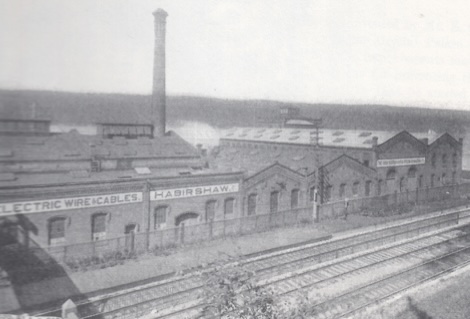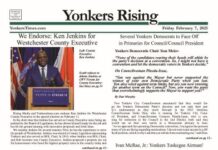
The Habirshaw Wire and Cable Company
By Mary Hoar, City of Yonkers Historian, Chair of Revolutionary Yonkers 250, President Emerita Yonkers Historical Society, recipient of the 2004 Key to History, Member of the Yonkers Landmarks Preservation Board, and President Untermyer Performing Arts Council
Monday, June 17th
June 17, 1907: The cornerstone of the new Sprain Ridge Hospital was laid; the hospital, donated by Alexander Smith Cochran, was founded to treat tuberculosis; Yonkers’ Mayor Coyne and Professor C. Irving Fisher of Yale were the main speakers.
Sprain Ridge, a thickly wooded valley, slope and crest, was one of the highest points in Westchester. The name Sprain Ridge was from Colonial times; Washington’s troops travelled the ridge going to and from the Battle of White Plains in 1776.
June 17, 1943: The famous Flying Fortress Memphis Belle landed safely at Washington’s National Airport. The original ten-member crew, including Yonkers native John Quinlan, was on the plane.
The Belle’s last mission was recorded and shown at several Yonkers movie theaters.
The crew was met in DC by several military officials, including Chief of Army Air Forces General Henry “Hap” Arnold, later the first commander of the US Air Force; Arnold was taught to fly by the Wright Brothers.
Tuesday, June 18th
June 18, 1944: Yonkers native William Tompkins, the last Civil War veteran in the area, passed away at the age of 97.
Tompkins ran away at the age of 15 to join the Union Army. He served as drummer boy, and drilled with troops in Washington DC before his mom found him and brought him home.
At the time of his death, he was the tenth oldest Mason in the world.
June 18, 1944: A police escort met the “Torch of Freedom” traveling group at the North Broadway city line and lead it to Larkin Plaza and thousands of waiting Yonkers residents.
City officials lit the Torch, a symbol of the cause of “liberty for which our men are fighting.” Besides hearing from military heroes accompanying the torch, local leaders of the Yonkers Homefront also spoke, encouraging all to purchase war bonds. After lighting, it was returned to the contingent of war heroes heading to its last stop of the day, New York City.
Wednesday, June 19th
June 19, 1852: The Yonkers Herald, Yonkers’ first newspaper, began publishing under the leadership of Thomas Smith.
June 19, 1939: Sisters at the Convent of the Blessed Sacrament on Park Avenue quickly squashed an item run by Walter Winchell in his “On Broadway” column!
Giving it the top position in his column, Winchell wrote: “Will Yonkers NY editors please check the rumor the widow of an ex-President is at the Convent of the Blessed Sacrament—preparing to be a nun?”
The sisters told The Herald Statesman, “There is no truth to the report whatsoever.”
Thursday June 20th
June 19, 1942: Mayor Benjamin Barnes demanded protection of the city’s waterfront and war industries; he requested the Common Council hire city guards and purchase a police boat.
June 20, 1949: Former Vice Mayor James Sullivan lost his appeal on his conviction on three felony counts in the Appellate Court on a 3-2 decision to uphold his conviction on all counts. He had been sentenced to serve one year in the Westchester County Penitentiary and fined $1000. Sullivan was out under $7,500 bail pending the results of his appeal. Since it was a close decision, it opened the way to file a new appeal.
The defense blamed the late labor leader William McGeory for the bookmaking installation; McGeory served as a Supervisor and Alderman while alive.
Friday, June 21st
June 21, 1907: The German Odd Fellows purchased the Tuckahoe Road home of James Courter, first Mayor of Yonkers, to use as a residence for old people. The building later became Hebrew National Orphan Home.
June 21, 1945: Yonkers native General Joseph Stilwell received a new assignment, command of the US Tenth Army; the Tenth was in the process of “mopping up Okinawa.” Previously Chief of the Army Ground Forces, he was appointed to the Pacific theater.
Saturday, June 22nd
June 12, 1914: More than 2,000 members of Holy Name Societies in the New York Archdiocese attended their annual meeting in St. Mary’s Church. The meeting was preceded by a parade through Getty Square.
June 22, 1928: The first full-length film feature with words shown in Westchester County opened at the Strand Theater. The Vitaphone movie, “Tenderloin,” starred Conrad Nagle and Dolores Costello was a swift-moving crime drama. Directed by Michael Curtiz, it was produced and released by Warner Brothers and was considered one of Curtiz’s most daring films. No prints are known to exist.
June 22, 1945: The US Navy commended Habirshaw Cable and Wire Corporation for its “outstanding performance in meeting quarterly schedules for Navy shipboard cable,” cable which “aided materially in construction of the US Fleet.” Copies of the letter from Admiral Cochrane were posted on all company bulletin boards.
Sunday, June 23rd
June 23, 1912: Commencement exercises at the John Mason School (School Six) on Ashburton Avenue not only marked the fiftieth anniversary of the school, but also marked the end of the twenty-five-year principalship of Amelia Walker.
June 23, 1943: Dorothy Dunbar Bromley’s interview with Yonkers resident Anita Brenner was published in the New York Herald Tribune. Brenner, author of The Wind That Swept Mexico on the history of the Mexican Revolution, discussed the roots of the “Zoot Suit Riots” in Los Angeles a few weeks earlier; she said many of the three million Mexican residents in our Western states were discriminated against in courts, schools, land ownership and medical facilities. Her solution? Americans must dissolve racial prejudice by appealing to our patriotism and religion.
Questions or comments on this column? Email YonkersHistory1646@gmail.com.
For information on the Yonkers Historical Society, Sherwood House and upcoming events, please visit its website www.yonkershistoricalsociety.org, call 914-961-8940 or email info@yonkershistoricalsociety.org





